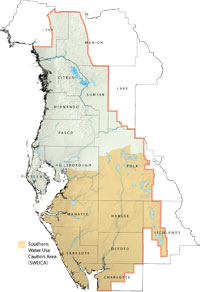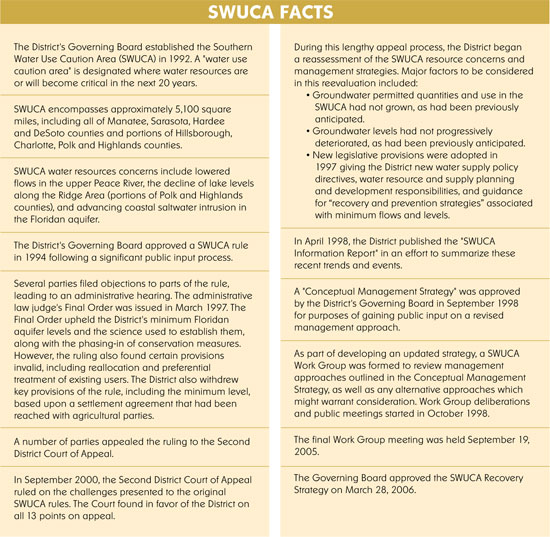
Nearly a decade of public workshops, water resource analyses and policy debates culminated recently in approval of the Southern Water Use Caution Area (SWUCA) Recovery Strategy by the District’s Governing Board.
“This is a historic moment for the District, the public and the water resources,” said Executive Director David Moore. “Many years of labor and collaboration by Board members, staff, representatives of all the types of water users and the general public went into fashioning this blueprint for restoring and protecting the water resources in the southern part of our District.”
The SWUCA is a 5,100-square-mile, eight-county area where depressed aquifer levels have caused salt water to intrude into the aquifer along the coast and contributed to reduced flows in the upper Peace River and lowered lake levels in portions of Polk and Highlands counties. (See sidebar at right.)
The purpose of the Recovery Strategy is to provide a plan for reducing the rate of saltwater intrusion, restoring flows in the upper Peace River and lake levels, while ensuring sufficient water supplies and protecting investments of existing water use permittees.
The Strategy has six basic components: conservation, alternative supply development, resource recovery projects, land use transitions, permitting, and monitoring and reporting.
Conservation
Improving how efficiently we use our water resources increases the number of uses that can be met by our limited supplies. The District promotes conservation practices among all user types. For example, the District partners with the Florida Department of Agriculture and Consumer Services to fund FARMS, a financial incentive program for the agricultural community to install best management practices for irrigation.
Alternative Supply Development
The primary water supply has been ground water. Developing alternative water supplies from sources such as surface waters, reclaimed water and desalination will reduce demand for stressed groundwater sources while meeting growing water needs.
Promoting conservation and alternative supply development are a continuation of longstanding District programs that, along with the District’s permitting program, have contributed to a trend of declining groundwater use in the SWUCA.
Resource Recovery Projects
In addition to developing new water supplies, the District is implementing resource recovery projects to enhance and restore existing water resources. For example, one project will raise the water level in Lake Hancock (which had been previously lowered through drainage), then release the excess water during the dry season to achieve minimum flows in the upper Peace River. Other projects under consideration include restoring mined lands and wetlands to store more water during wet seasons.
To be successful, these conservation, alternative supply and resource recovery projects require funding. There is a need for about $673 million through the year 2025. The Strategy identifies about $559 million available through various sources, highlighting the need to maintain a budget capable of supporting these projects.
Land Use Transitions
Almost all property within the SWUCA has a water use permit associated with it. The trend in land use changes is for urban/suburban land uses to displace nonresidential land uses, primarily agriculture, that have depended on ground water. Along the coastal communities in the SWUCA, the Strategy anticipates meeting the water needs of these new land uses through alternative supplies, which will help reduce groundwater withdrawals. In the inland counties, where alternative supplies such as surface water are not as plentiful, it is anticipated that new uses can be met, in part, with ground water that the displaced farms previously used.
Permitting
The District permitting program requires water use permit holders to be efficient through conservation measures and to use alternative water sources where they are economically, technologically and environmentally practical.
An applicant wanting to pump new quantities from the Floridan aquifer will have to demonstrate that the withdrawal will not impact an area where the water resources have already been designated as below a minimum flow or level (MFL). If the withdrawal would impact an MFL water body, the applicant will need to show at least a 10 percent improvement or net benefit to the water body. The net benefit can be achieved by showing the new use is actually less than an existing use being retired or displaced, or by participating in a mitigation or resource development project.
Monitoring and Reporting
The District will use an extensive monitoring network to look at actual versus anticipated trends in water levels, flows and saltwater intrusion. Projections of water demands and potential sources will be updated every five years as part of the Regional Water Supply Plan.
The District will also have an ongoing cumulative impact analysis that will look at all factors affecting recovery. This comprehensive monitoring and analysis will allow the Governing Board to make any necessary midcourse corrections and ensure recovery is ultimately achieved.

